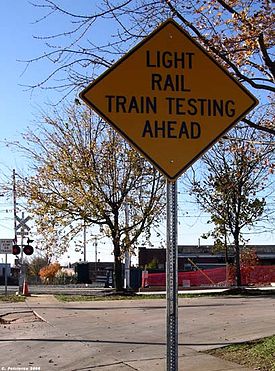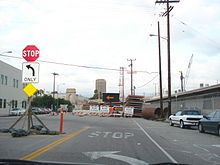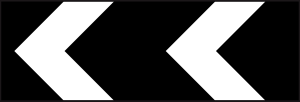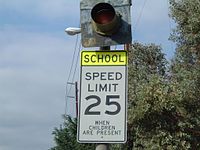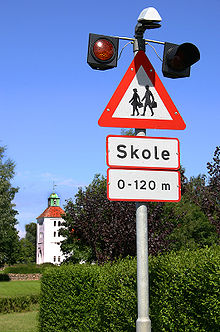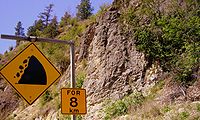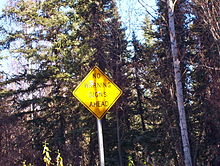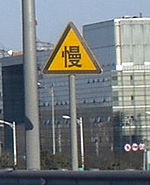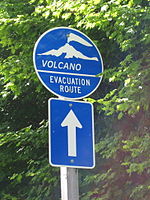- Warning sign
-
A traffic warning sign is a type of traffic sign that indicates a hazard ahead on the road that may not be readily apparent to a driver.[1]
In most countries, they usually take the shape of an equilateral triangle with a white background and a thick red border. However, both the color of the background and the color and thickness of the border varies from country to country.
In the People's Republic of China (except for Macau and Hong Kong), warning signs appear with a black border and a yellow background. In Sweden, Serbia, Bosnia and Herzegovina, Croatia, Greece, Finland, Iceland, the Republic of Macedonia and Poland, they have a red border with an amber background. This is due to the weather, as it is easier to see a red/amber sign in the snowy weather than a red/white sign. The polar bear warning sign in Svalbard recently changed from displaying a black bear on white background to a white bear on black background (both signs are triangular with a red border). Some countries (like France, Norway, Spain) that normally use a white background have adopted an orange or amber background for road work or construction signs.
Warning signs in some countries have a diamond shape in place of the standard triangular shape. In the United States, Canada, Mexico, Thailand, Australia, Japan, Philippines, Indonesia, Malaysia, New Zealand, most of South America, and also Ireland (diverging from the standards of the rest of Europe) use warning signs are black on a yellow background and usually diamond-shaped, while temporary signs (which are typically construction signs) are black on an orange background. Some other countries also use these standards for some signage.
The warning signs usually contain a symbol. In Europe they are based on the UNECE Vienna Convention on Road Signs and Signals. In United States they are based on their own standard and often contain text only.
- Sample Shapes and Colors
History
In 1908 the automobile association in West London set the first warning signs.
Warning signs
Warning signs can indicate any potential hazard, obstacle or condition requiring special attention. Some of the most common warning signs are the following.
General caution
General warning signs are used in instances in which the particular hazard, obstacle or condition is not covered by a standard sign. In Europe, they usually comprise an exclamation mark on the standard triangular sign (Unicode #9888: ⚠) with an auxiliary sign below in the local language identifying the hazard, obstacle or condition. In countries using diamond-shaped signs, the explanatory language is written directly on the diamond-shaped sign, although it may contain only a general warning such as "Caution", and pictograms may also be used as it has been initiated at first in Quebec.
Obstacles
Diamond-shaped with reflectors are placed at point of curbs, dividers, or other lane obstacles. Rectangular signs with diagonal stripes indicate solid objects such as barricades, bridge abutments, utility poles or natural obstacles near the roadway. Left side obstacles are marked with stripes running high to low, left to right; right side obstacle signs use stripes running high to low, right to left; in a sense akin to International symbol of arrow pointing down toward side toward roadway.
Animals crossing the roadway
Signs may warn of wild animals (moose, bear, elk, deer, reindeer, polar bears, camels, wallabies, kangaroos, alligators, etc.) or farm animals (cows, horses, ducks, sheep) that may stray onto the road. In the United States, a SHARE THE ROAD plaque is sometimes placed below these warning signs when used in this manner.
-
Pennsylvania duck crossing sign
-
Italy, Germany and Latvia wild animal crossing sign
-
Camel warning sign in the UAE
-
Danger of encountering polar bears - "Applies to all Svalbard"
Odd vehicles crossing the roadway
Also equipment (tractors, forklifts, snowmobiles, Amish buggies etc.) crossing or traveling along the road.
Road works or construction
These signs are often temporary in nature and used to indicate road works (construction), poor roads, or temporary conditions ahead on the road including: flagmen, survey crew, single-lane, detour, bridge out, utility crew ahead, blasting area, bump, dip, frost heaves, flooding (or "High water"), soft shoulder, uneven pavement, freshly oiled road, loose gravel, smoke on road, trucks entering, etc. (note that some high water signs are posted to alert drivers of a flood prone area and do not actually mean that there is a flooded section of road ahead) In France, Italy, Spain, Norway etc., warning (and speed limit) signs connected with road works have yellow background, these countries normally have white background on signs. In America and Ireland, signs connected with road works have orange background.
Curves and corners
These signs indicate that ahead are dangerous or unexpected bends in the road, some being continuous, others being sharp-ended. Signs may indicate whether the curves are to the right or to the left and whether the degree to which the curves or bends are sharp. They mays also indicate a series of curves or bends ahead.
-
Republic of Ireland sharp corner (Advisory speed <30 mph)
-
U.S. curve to the right sign, with advisory speed limit.
Chevrons and arrows
Chevron shaped symbols or arrows on rectangular signs may be placed at the actual location of the bend or curve to further mark the location of the curve and to assist in negotiation of the curve. They may also be used to indicate "merge" with other traffic, as for an on-ramp of a limited-access highway.
Tunnels
The signs are used to indicate tunnels, where lights are usually required, and a general change in the light level. May also indicate low ceiling clearance. Truck drivers should also watch for prohibited cargo signs (e.g., Hazmat, propane, explosives) upon approach to tunnels.
Bridges
These signs are used where traffic may be constricted to a narrow bridge, or where the bridge may have a movable span closed to vehicles while boats pass (e.g., drawbridge or floating bridge). They may also be used for underpass to indicate low overhead clearance.
-
Italy draw bridge ahead sign. In Latvia, the bridge on the sign is without the rails.
Traffic signals
These warning signs indicate that traffic lights are ahead, and are often used when it is difficult to see that a traffic light may already be showing red, to warn a driver to prepare to slow down. They may be supplemented with flashing light or lighted sign when light is red or turning red.
Warning signs for regulatory signs
As for traffic signals, above, some "stop" or "yield" signs may require additional warning or reminder, especially in dense areas or where the sign has been added recently.
Level crossings and intersections
These signs warn of road crossings at even level (crossroads, T-intersection, forks (Y-intersection), rotary/roundabout). They may also indicate "hidden driveway" intersecting the road ahead. (Compare with bridges/overpasses/viaducts).
- Roundabouts/Rotaries
Lane starts and ends
These signs indicate when a multilane highway is being narrowed, when a passing lane is ending, or where the road is widening or a passing lane starting. Another type of sign is used to indicate central "two-way" left turning lane in center of roadway. Warning signs may also warn of "Highway ends", where the road changes class or type.
Roads with one entry point
Roadways that only have one entry/exit point - "dead end", "not a through street" or "no outlet".
No passing zones
Vertical yellow signs in triangular shape are used in U.S. to supplement solid yellow lane stripe where it is dangerous to overtake another vehicle, especially where roadway may be obscured by snow or other precipitation.
Pedestrian crossings
The signs are used to warn drivers of people walking in the street. They may also be used to warn of children playing, playgrounds, bicycle area, deaf child, blind pedestrians, and thickly settled zones where pedestrians may enter the road.
In California, United States near the Mexican border, there are warning signs showing a running family. This is to warn motorists to look out for illegal immigrants who try to escape authorities by running through freeway traffic. The symbol was created by California Department of Transportation employee John Hood in the late 1980s.[2]
Schools
The signs mark school zones (in which lower speed limits may be in place), student crossings, crossing guards or signals ahead. In the U.S. and Canada, pentagon shaped signs are used in place of the usual diamond-shaped signs. The shape of the U.S. school zone resembles a one-room school house and is the only U.S. sign shaped this way. Some Canadian provinces use an identical sign. Ontario uses a white on blue version of this sign.[3]
Bicycle
Other signs with unprotected people
Fire stations
These signs warn of approach to where firefighters may be entering the road with fire engines or other emergency apparatus, where other drivers will have to stop and wait until they pass.
Oncoming traffic
The signs may be used to warn people of oncoming traffic; shown when a motorway becomes a dual carriageway or a normal road without a central reservation or median.
Level crossing/Railway crossing
These signs are used to warn of level crossings ahead. In most countries a red triangle warning sign is used, with various pictograms for unguarded crossings, crossings with manual gates, and automatic level crossings. In most of Europe an old style gate is used for a crossing with gates, and a steam locomotive for a crossing without gates. Similar pictograms are also used in Ireland albeit on an amber diamond sign. In the United States the warning of all types of railway crossings is made using a circular yellow sign. The actual crossing is also marked with crossed "Railroad Crossing" crossbuck signs (Stop, look, listen) and possibly lights, bells, and barriers.
- Crossing with Gate
- Unguarded Crossing
- Other Crossings
- Warning at Crossing
Falling rocks
These signs may be used to indicate the hazards of fallen or falling rocks on the road ahead. They are usually pictographs, but may also include wording, such as "fallen rock", "falling rock", or "rock slide". In Italy the words may be "caduta sassi" or "caduta massi"; in France "chûte de pierres"; in Mexico "derrumbes".
For example, a warning sign with the image of an aircraft in the middle of it indicates an airport or airfield, where drivers should be prepared for low-flying aircraft.
Road conditions
"Slippery when wet", "grooved pavement" (warning to motorcyclists and bicyclists), "Open joints on bridge", "Icy Road", "Bridge freezes before roadway" and variants thereof, and "bump" or "dip" ahead (not related to construction). Truck drivers will need to pay attention to "Steep grade" warnings (or "Down grade, use lower gear"), sometimes posted with the percent grade (e.g., 5 percent). Steep hills may also feature "Runaway truck escape" or "Emergency stop" areas with corresponding signs. The UK has a sign warning of "Adverse camber" on a curve. Also "Loose gravel", "Soft shoulder", "Speed hump", and "Watch for Ice."
- Slippery Pavement
-
German slippery pavement sign.
- Steep Grade
-
Poland steep grade sign.
- Bumpy Road
- Other
Crosswinds or Side winds
Flying socks, as indicated by a windsock on red triangle or yellow diamond signs, indicate locations where a strong side wind may cause the trajectory of the moving vehicle to change drastically, perhaps even "flying" across lanes, causing an accident.
Slow down
General caution signs warning motorists to slow down are sometimes used at least in U.S. and China.
Merge to stay with through traffic
In the United States and Canada, there is special signage for lanes that are about to exit, so that drivers who wish to remain on the main road have adequate time to merge. Such lanes are sometimes indicated by special striping ("alligator stripes") and the sign, "Thru Traffic Merge Left" (or right). On freeways, the green directions sign for the exit ramp may have the additional notation, "Exit Only," and should have black letters on a yellow background for emphasis.
Warning signs with lights
Some warning signs have flashing lights to alert drivers of conditions ahead or remind drivers to slow down. In Britain, they are called warning light.
Evacuation routes
Some areas have special evacuation route signs that are to be followed in case of certain disasters. The signs point to routes either to safety or to less danger.
Evacuation signs are common in areas where there is a high risk of dangers such as flash flooding, volcanic activity and lahar, tsunami, hurricane and storm surge. For example, along the Japanese shorelines, the tsunami warning signs are linked with a network of warning sirens, typically at the top of the cliff of surroundings hills.[4]
Non-traffic warning signs
Warning signs are also found on other potential dangerous sites. At the base of electricity pylons or fences of substations or radiotechnical equipment with open parts leading high voltage, there are signs warning of high voltage. Warning signs can be found at the top of inclines. "Beware of Dog" is a typical warning of the presence of a dog, but there is no standard sign design.
See also
Notes
- ^ Federal Highway Administration. "Section 1A.13 Definitions of Words and Phrases in This Manual". Manual on Uniform Traffic Control Devices (2003 ed.). Washington, DC. p. 1A-14. http://mutcd.fhwa.dot.gov/htm/2003r1r2/part1/part1a.htm. Retrieved 2009-03-01. "Warning Sign—a sign that gives notice to road users of a situation that might not be readily apparent."
- ^ Highway safety sign becomes running story on immigration | The San Diego Union-Tribune
- ^ Driver's Handbook
- ^ Chanson, H. (2010). Tsunami Warning Signs on the Enshu Coast of Japan. Shore & Beach, Vol. 78, No. 1, pp. 52-54. ISSN 4237 0037 4237. http://espace.library.uq.edu.au/view/UQ:203103.
Traffic signs Signs Warning sign · Regulatory sign · Priority to the right · Yield sign · Stop sign · Prohibitory traffic sign · One-way traffic · Speed limit (by country) · Advisory speed limit · Mandatory sign · Special regulation sign · Information sign · Direction, position, or indication sign · Variable-message sign · Bilingual sign · Comparison of European traffic signs · Driver location signs · CrossbuckBy country Lights Typefaces Allerta · Austria (typeface) · Clearview · DIN 1451 · Drogowskaz · FHWA Standard Alphabets for Traffic Control Devices · Frutiger · Caractères · NPS Rawlinson Roadway · Trafikkalfabetet · Transport · TratexConventions Geneva Convention on Road Traffic · Vienna Convention on Road Traffic · Vienna Convention on Road Signs and Signals · Manual on Uniform Traffic Control Devices (USA) · Traffic Signs Regulations and General Directions (UK)
Wikimedia Foundation. 2010.










































